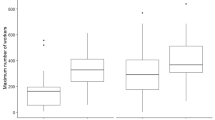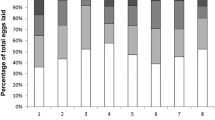Abstract
A reproductive division of labor between subordinates and established reproductives is a hallmark of eusociality. In most groups, however, workers retain some reproductive capabilities. Across insect societies, measures of successful worker reproduction in the presence of a queen, with few exceptions, indicate that worker reproduction is kept at very low levels. There are, however, certain colony-level characteristics that may influence the degree to which worker reproduction is promoted, such as queen number, queen mating frequency, and physical presence of a queen in species with multiple nesting sites (polydomy). In this study, the level of worker reproduction in field colonies of the ant species Aphaenogaster cockerelli was measured. A. cockerelli is a monogynous and polydomous species, so worker reproduction across nesting sites was investigated. None of the 297 males sampled provided any evidence of worker reproduction. Worker reproduction would have been detectable if it was present at or above a level of 1.5 % of the total males per colony. An effective mating frequency for queens of this species was found to be 1.03. Although A. cockerelli colonies have many colony-level factors potentially promoting worker reproduction (workers with active, trophic egg-producing ovaries, a single singly-mated queen, workers who are physically separated from the queen), it is evident that worker reproduction is highly regulated. Synthesizing the extensive amount of policing and fertility signaling data previously reported on this species, A. cockerelli is presented as case study for how worker reproduction is repressed and cooperation is maintained in insect societies.
Similar content being viewed by others
References
Banschbach V.S. and Herbers J.M. 1996. Complex colony structure in social insects. 2. Reproduction, queen-worker conflict, and levels of selection. Evolution 50: 298-307
Barron A.B., Oldroyd B.P. and Ratnieks F.L.W. 2001. Worker reproduction in honey-bees (Apis) and the anarchic syndrome: a review. Behav. Ecol. Sociobiol. 50: 199-208
Bourke A.F.G. 1988. Worker reproduction in the higher eusocial Hymenoptera. Q. Rev. Biol. 63: 291-311
Bourke A.F.G., Green H.A.A. and Bruford M.W. 1997. Parentage, reproductive skew and queen turnover in a multiple-queen ant analysed with microsatellites. Proc. R. Soc. Lond. B 264: 277-283
Brandvain Y. and Wade M.J. 2007. The evolution of competition and policing: opposing selection within and among groups. BMC Evol. Biol. 7: 203
Brunner E., Trindl A., Falk K.H., Heinze J. and D’Ettorre P. 2005. Reproductive conflict in social insects: male production by workers in a slave-making ant. Evolution 59: 2480-2482
Cerda X., Dahbi A. and Retana J. 2002. Spatial patterns, temporal variability, and the role of multi-nest colonies in a monogynous Spanish desert ant. Ecol. Entomol. 27: 7-15
Choe J.C. 1988. Worker reproduction and social evolution in ants (Hymenoptera: Formicidae). In: Advances in Myrmecology (Trager J.C., Ed). E.J. Brill, Leiden, New York. pp 163-187
Cuvillier-Hot V., Cobb M., Malosse C. and Peeters C. 2001. Sex, age and ovarian activity affect cuticular hydrocarbons in Diacamma ceylonense, a queenless ant. J. Insect Physiol. 47: 485-493
D’Ettorre P., Heinze J. and Ratnieks F.L.W. 2004. Worker policing by egg eating in the ponerine ant Pachycondyla inversa. Proc. R. Soc. Lond. B 271: 1427-1434
Denis D., Pezon A. and Fresneau D. 2007. Reproductive allocation in multinest colonies of the ponerine ant Pachycondyla goeldii. Ecol. Entomol. 32: 289-295
Dietemann V., Peeters C., Liebig J., Thivet V. and Hölldobler B. 2003. Cuticular hydrocarbons mediate discrimination of reproductives and nonreproductives in the ant Myrmecia gulosa. Proc. Natl Acad. Sci. USA 100: 10341-10346
Endler A., Liebig J. and Hölldobler B. 2006. Queen fertility, egg marking and colony size in the ant Camponotus floridanus. Behav. Ecol. Sociobiol. 59: 490-499
Endler A., Liebig J., Schmitt T., Parker J.E., Jones G.R., Schreier P. and Hölldobler B. 2004. Surface hydrocarbons of queen eggs regulate worker reproduction in a social insect. Proc. Natl Acad. Sci. USA 101: 2945-2950
Foster K.R. and Ratnieks F.L.W. 2001. Convergent evolution of worker policing by egg eating in the honeybee and common wasp. Proc. R. Soc. Lond. B 268: 169-174
Foster K.R., Ratnieks F.L.W. and Raybould A.F. 2000. Do hornets have zombie workers? Mol. Ecol. 9: 735-742
Gobin B., Billen J. and Peeters C. 1999. Policing behaviour towards virgin egg layers in a polygynous ponerine ant. Anim. Behav. 58: 1117-1122
Hammond R.L. and Keller L. 2004. Conflict over male parentage in social insects. PLoS Biol. 2: 1472-1482
Hannonen M., Sledge M.F., Turillazzi S. and Sundström L. 2002. Queen reproduction, chemical signalling and worker behaviour in polygyne colonies of the ant Formica fusca. Anim. Behav. 64: 477-485
Hartmann A., Wantia J., Torres J.A. and Heinze J. 2003. Worker policing without genetic conflicts in a clonal ant. Proc. Natl Acad. Sci. USA 100: 12836-12840
Helanterä H. and Sundström L. 2005. Worker reproduction in the ant Formica fusca. J. Evol. Biol. 18: 162-171
Helanterä H. and Sundström L. 2007. Worker reproduction in Formica ants. Am. Nat. 170: E14-E25
Herbers J.M., DeHeer C.J. and Foitzik S. 2001. Conflict over sex allocation drives conflict over reproductive allocation in perennial social insect colonies. Am. Nat. 158: 178-192
Herbers J.M. and Mouser R.L. 1998. Microsatellite DNA markers reveal details of social structure in forest ants. Mol. Ecol. 7: 299-306
Hölldobler B. and Carlin N. 1989. Colony founding, queen control and worker reproduction in the ant Aphaenogaster (=Novomessor) cockerelli (Hymenoptera: Formicidae). Psyche 96: 131-151
Ito F., Higashi S. and Maeta Y. 1988. Growth and development of Camponotus (Paramyrmamblys) kiusiuensis Santschi colonies (Hym. Formicidae). Insect. Soc. 35: 251-261
Iwanishi S., Hasegawa E. and Ohkawara K. 2003. Worker oviposition and policing behaviour in the myrmicine ant Aphaenogaster smythiesi japonica Forel. Anim. Behav. 66: 513-519
Johnson R.A. 2000. Seed-harvester ants (Hymenoptera: Formicidae) of North America: an overview of ecology and biogeography. Sociobiology 36: 89-122
Kikuta N. and Tsuji K. 1999. Queen and worker policing in the monogynous and monandrous ant, Diacamma sp. Behav. Ecol. Sociobiol. 46: 180-189
Liebig J. 2010. Hydrocarbon profiles indicate fertility and dominance status in ant, bee, and wasp colonies. In: Insect Hydrocarbons: Biology, Biochemistry, and Chemical Ecology (Blomquist G.J. and Bagnères A.G., Eds), Cambridge University Press, Cambridge. pp 254-281
Liebig J., Peeters C. and Hölldobler B. 1999. Worker policing limits the number of reproductives in a ponerine ant. Proc. R. Soc. Lond. B 266: 1865-1870
Liebig J., Peeters C., Oldham N.J., Markstädter C. and Hölldobler B. 2000. Are variations in cuticular hydrocarbons of queens and workers a reliable signal of fertility in the ant Harpegnathos saltator? Proc. Natl Acad. Sci. USA 97:4124-4131
Moilanen A., Sundström L. and Pedersen J.S. 2004. MATESOFT: a program for deducing parental genotypes and estimating mating system statistics in haplodiploid species. Mol. Ecol. Notes 4: 795-797
Monnin T. 2006. Chemical recognition of reproductive status in social insects. Ann. Zool. Fenn. 43: 515-530
Monnin T. and Peeters C. 1999. Dominance hierarchy and reproductive conflicts among subordinates in a monogynous queenless ant. Behav. Ecol. 10: 323-332
Page R.E. and Erickson E.H. 1988. Reproduction by worker honey bees (Apis mellifera L.). Behav. Ecol. Sociobiol. 23: 117-126
Pamilo P. 1991. Evolution of colony characteristics in social insects. 2. Number of reproductive individuals. Am. Nat. 138: 412-433
Peeters C. and Liebig J. 2009. Fertility signaling as a general mechanism of regulating reproductive division of labor in ants. In: Organization of Insect Societies: From Genome to Sociocomplexity (Gadau J. and Fewell J., Eds), Harvard University Press, Cambridge. pp 220-242
Ratnieks F.L.W. 1988. Reproductive harmony via mutual policing by workers in eusocial Hymenoptera. Am. Nat. 132: 217-236
Ratnieks F.L.W. 1993. Egg-laying, egg-removal, and ovary development by workers in queenright honey bee colonies. Behav. Ecol. Sociobiol. 32: 191-198
Ratnieks F.L.W., Foster K.R. and Wenseleers T. 2006. Conflict resolution in insect societies. Annu. Rev. Entomol. 51: 581-608
Ratnieks F.L.W. and Reeve H.K. 1992. Conflict in single-queen Hymenopteran societies - the structure of conflict and processes that reduce conflict in advanced eusocial species. J. Theor. Biol. 158: 33-65
Smith A.A. and Haight K.L. 2008. Army ants as research and collection tools. J. Insect Sci. 8: 71
Smith A.A., Hölldobler B. and Liebig J. 2008. Hydrocarbon signals explain the pattern of worker and egg policing in the ant Aphaenogaster cockerelli. J. Chem. Ecol. 34: 1275-1282
Smith A.A., Hölldobler B. and Liebig J. 2009. Cuticular hydrocarbons reliably identify cheaters and allow enforcement of altruism in a social insect. Curr. Biol. 19: 78-81
Smith A.A., Hölldobler B. and Liebig J. 2011. Reclaiming the crown: queen to worker conflict over reproduction in Aphaenogaster cockerelli. Naturwissenschaften 98: 237-240
Smith A.A., Hölldobler B. and Liebig J. 2012. Queen-specific signals and worker punishment in the ant Aphaenogaster cockerelli: the role of the Dufour’s gland. Anim. Behav. 83: 587-593
Smith C.R., Schoenick C., Anderson K.E., Gadau J. and Suarez A.V. 2007. Potential and realized reproduction by different worker castes in queen-less and queen-right colonies of Pogonomyrmex badius. Insect. Soc. 54: 260-267
Snyder L.E. and Herbers J.M. 1991. Polydomy and sexual allocation ratios in the ant Myrmica punctiventris. Behav. Ecol. Sociobiol. 28: 409-415
Tsuchida K., Saigo T., Nagata N., Tsujita S., Takeuchi K. and Miyano S. 2003. Queen-worker conflicts over male production and sex allocation in a primitively eusocial wasp. Evolution 57: 2365-2373
Van Dyken J.D., Linksvayer T.A. and Wade M.J. 2011. Kin selection-mutation balance: a model for the origin, maintenance, and consequences of social cheating. Am. Nat. 177: 288-300
van Zweden J.S., Furst M.A., Heinze J. and D’Ettorre P. 2007. Specialization in policing behaviour among workers in the ant Pachycondyla inversa. Proc. R. Soc. Lond B 274: 1421-1428
Visscher P.K. 1989. A quantitative study of worker reproduction in honey bee colonies. Behav. Ecol. Sociobiol. 25: 247-254
Wenseleers T., Helanterä H., Hart A. and Ratnieks F.L.W. 2004. Worker reproduction and policing in insect societies: an ESS analysis. J. Evol. Biol. 17: 1035-1047
Wenseleers T. and Ratnieks F.L.W. 2006. Comparative analysis of worker reproduction and policing in eusocial Hymenoptera supports relatedness theory. Am. Nat. 168: 163-179
Author information
Authors and Affiliations
Corresponding author
Rights and permissions
About this article
Cite this article
Smith, A.A., Overson, R.P., Hölldobler, B. et al. The potential for worker reproduction in the ant Aphaenogaster cockerelli and its absence in the field. Insect. Soc. 59, 411–416 (2012). https://doi.org/10.1007/s00040-012-0235-9
Received:
Revised:
Accepted:
Published:
Issue Date:
DOI: https://doi.org/10.1007/s00040-012-0235-9




